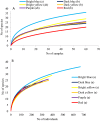Wild bees respond differently to sampling traps with vanes of different colors and light reflectivity in a livestock pasture ecosystem
- PMID: 35697722
- PMCID: PMC9192518
- DOI: 10.1038/s41598-022-10286-w
Wild bees respond differently to sampling traps with vanes of different colors and light reflectivity in a livestock pasture ecosystem
Abstract
Wild bees are important pollinators and monitoring their abundance and diversity is necessary to develop conservation protocols. It is imperative to understand differences in sampling efficiency among different trap types to help guide monitoring efforts. This study used a new vane trap design to collect bees in a livestock pasture ecosystem and examined the impact of six different vane colors on wild bee sampling. We recorded 2230 bees comprising 49 species and five families. The most abundant species were Augochlorella aurata (25.8%), Lasioglossum disparile (18.3%), Lasioglossum imitatum (10.85%), Agapostemon texanus (10.8%), Melissodes vernoniae (9.9%) and Halictus ligatus (4.7%). Traps with bright blue vanes captured the greatest number and diversity of bees as compared to traps with bright yellow, dark blue, dark yellow, and purple vanes. Red vanes had the lowest captures rates of individuals and species. Different colors were associated with different bee species arrays and only nine species were found in all vane color types. Vanes with higher light reflectance properties (within 400-600 nm range) attracted the greatest number of bees. These results show that different light wavelengths and reflectivity of vane traps influence bee capture rates, and such findings can help optimize bee sampling methods in different ecosystems.
© 2022. The Author(s).
Conflict of interest statement
The authors declare no competing interests.
Figures






References
-
- Ollerton J, Winfree R, Tarrant S. How many flowering plants are pollinated by animals? Oikos. 2011;120:321–326. doi: 10.1111/j.1600-0706.2010.18644.x. - DOI
-
- Potts, S. G. et al. The assessment report on pollinators, pollination and food production: summary for policymakers. (Secretariat of the Intergovernmental Science-Policy Platform on Biodiversity and Ecosystem Services Fourth Session, Kuala Lampur, 22–28 February, 2016).
-
- Cane JH, Minckley RL, Kervin LJ. Sampling bees (Hymenoptera: Apiformes) for pollinator community studies: pitfalls of pan-trapping. J. Kansas Entomol. Soc. 2000;73:225–231.
-
- Jousselin E, Kjellberg F. The functional implications of active and passive pollination in dioecious figs. Ecol. Lett. 2001;4:151–158. doi: 10.1046/j.1461-0248.2001.00209.x. - DOI
Publication types
MeSH terms
LinkOut - more resources
Full Text Sources

